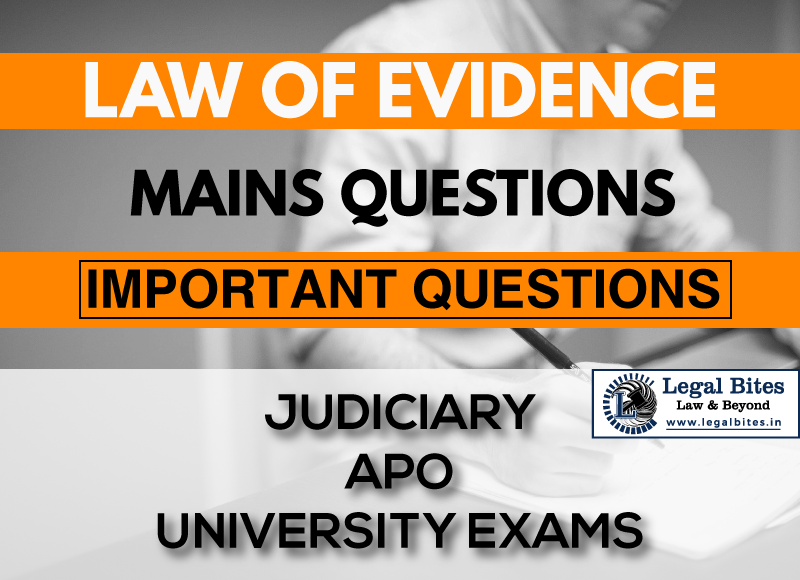Relevancy of facts | A commits rape of B in a lonely place. After committing rape A goes away and the victim returned home….. Give reasons and also refer to case law, if any, on the point.
Question: Relevancy of facts | A commits rape of B in a lonely place. After committing rape A goes away and the victim returned home. When B comes home, she makes a statement regarding such rape to her sister C. Is the statement made to C by B, regarding rape, relevant under Section 6, as forming part of… Read More »

Question: Relevancy of facts | A commits rape of B in a lonely place. After committing rape A goes away and the victim returned home. When B comes home, she makes a statement regarding such rape to her sister C. Is the statement made to C by B, regarding rape, relevant under Section 6, as forming part of the same transaction? Give reasons and also refer to case law, if any, on the point. Find the answer to the mains question only on Legal Bites. [Relevancy of facts | A commits rape of B in...
Question: Relevancy of facts | A commits rape of B in a lonely place. After committing rape A goes away and the victim returned home. When B comes home, she makes a statement regarding such rape to her sister C.
Is the statement made to C by B, regarding rape, relevant under Section 6, as forming part of the same transaction? Give reasons and also refer to case law, if any, on the point.
Find the answer to the mains question only on Legal Bites. [Relevancy of facts | A commits rape of B in a lonely place. After committing rape A goes away and the victim returned home….. Give reasons and also refer to case law, if any, on the point.]
Answer
Section 6 of the Indian Evidence Act which provides for relevancy of facts forming part of the same transaction states as Facts which, though not in issue, are so connected with a fact in issue as to form part of the same transaction, are relevant, whether they occurred at the same time and place or at different times and places
Illustration (b) indicates that acts done at different places and times may form part of the same transaction. Thus, a transaction consists both of the physical acts and the words accompanying such physical acts, whether spoken by the person doing such acts, the person to whom they were done, or any other person or persons. Such words are admissible in evidence as parts of a transaction.
In Rattan v. Reginam [(1971) 1 WLR 801] and trying to lay down a more rational formula, Lord Wilberforce said-
“The test should not be the uncertain one whether the making of the statement was in some sense part of the event or transaction. This may often be difficult to establish; such external matters as the time which elapses between the events and the speaking of the words (or vice versa) and differences in the location being relevant factors but not, taken by themselves, decisive criteria. As regards statements made after the event it must be for the judge to satisfy himself that the statement was so clearly made in circumstances of spontaneity or involvement in the event that the possibility of concoction can be disregarded. Conversely, if he considers that the statement was made by way of narrative of a detached prior event so that the speaker was disengaged from it as to be able to construct or adapt his account, he should exclude it”.
In the case in hand, the accused raped 'B’, and immediately after the departure of the accused from the place, B came home and told this fact to her sister. So after the commission of a crime, the victim has given an account of the occurrence immediately to her sister, it forms a continuous transaction and thus is admissible u/s 6 as relevant.
According to Section 8 of the Act, the relevant fact is the conduct; and a statement is relevant in so far as it explains or accompanies conduct which itself is relevant.
If a person against whom an offence has been committed, shortly after the occurrence, makes a complaint, the relevant conduct is the act of making the complaint; and the terms of the complaint become relevant because they accompany and explain the act of making the complaint.
If the aggrieved person does not make a complaint, but only makes a statement, the statement is not relevant under Section 8 as it does not explain or accompany any conduct. Therefore, the statement made by a ravished woman immediately after she has been ravished is not admissible in evidence.
And since admissibility and relevancy of evidence is a totally different thing under the IEA, the facts of the case being only relevant under section 6 and not admissible under section 8 of the act.
Important Mains Questions Series for Judiciary, APO & University Exams
- Law of Evidence Mains Questions Series Part-I
- Law of Evidence Mains Questions Series Part-II
- Law of Evidence Mains Questions Series Part-III
- Law of Evidence Mains Questions Series Part-IV
- Law of Evidence Mains Questions Series Part-V
- Law of Evidence Mains Questions Series Part-VI
- Law of Evidence Mains Questions Series Part-VII
- Law of Evidence Mains Questions Series Part-VIII
- Law of Evidence Mains Questions Series Part-IX
- Law of Evidence Mains Questions Series Part-X
Admin Legal Bites
Legal Bites Study Materials correspond to what is taught in law schools and what is tested in competitive exams. It pledges to offer a competitive advantage, prepare for tests, and save a lot of money.
